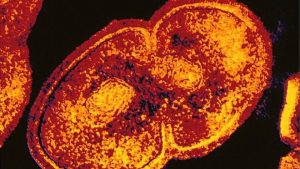May
30
2017
 Imagine a day where you get a bacterial infection, and the doctors tell you that there is no antibiotic which is effective against this bug. It is resistant to everything we have. They can give you supportive care, but the infection just has to run its course and may be fatal. For this reason hospitals have to take extreme measures to prevent the spread of infection – disinfecting and wearing disposable protective garments each time they enter a patient’s room. This is already the case for patients with certain kinds of exposures and infections.
Imagine a day where you get a bacterial infection, and the doctors tell you that there is no antibiotic which is effective against this bug. It is resistant to everything we have. They can give you supportive care, but the infection just has to run its course and may be fatal. For this reason hospitals have to take extreme measures to prevent the spread of infection – disinfecting and wearing disposable protective garments each time they enter a patient’s room. This is already the case for patients with certain kinds of exposures and infections.
This is a serious concern, not hype like most of the doomsday scenarios the press likes to scare you with. Bacteria are slowly (or sometimes not that slowly) evolving resistance to our antibiotics. Even worse, bacteria have loops of DNA called plasmids which they can share with each other. Those plasmids might contain the code for resistance to one or more antibiotics. The more we use antibiotics, the more selective pressure there is for resistance.
The two main things we need to do to avoid a “post-antibiotic era” includes first uses antibiotics as smartly as possible. Use them only when necessary, use narrow-spectrum antibiotics when possible, and complete all courses of antibiotics so all the bacteria are killed.
The second thing we need to do is develop more and better antibiotics. Attacking bacteria using new mechanisms is especially useful. Ideally these antibiotics would be resistant to resistance – they would attack a vulnerability in the bacteria that they cannot easily evolve a defense against.
Continue Reading »
May
26
2017
 I saw this post on the Credible Hulk Facebook page today. It refers to an old claim by proponents of ancient astronaut theories that the fact that there are similar looking pyramids from different locations on Earth proves cultural contamination from an extraterrestrial source.
I saw this post on the Credible Hulk Facebook page today. It refers to an old claim by proponents of ancient astronaut theories that the fact that there are similar looking pyramids from different locations on Earth proves cultural contamination from an extraterrestrial source.
While this is a silly argument, it is interesting to explore exactly why it is silly. The underlying principles have to do with homology and analogy, and are exactly the same as they are applied in evolutionary theory. The displayed meme implies that because there are step pyramids in Mexico, Egypt, and Indonesia – countries too far removed to have had direct contact with each other – the idea of a step pyramid therefore had a common source.
This is similar to the evolutionary argument that because two structures look similar or serve a similar function, they must have had a common source, which means the feature was derived from a common ancestor. But we know that this is not always true. The wings of bats, birds, and pterydactyls have similar features, but not a common evolutionary origin. The eyes of vertebrates and cephalopods also have features in common, but evolved independently. But giraffes and humans both have seven cervical vertebrae.
So how do evolutionary biologists tell the difference? They try to determine if the features are homologous (derive from a common ancestor) or analogous (independent origins but similar structure). They can do this in a number of ways, either based on direct evidence or inference. Direct evidence would be finding a fossil of a common ancestor with the feature.
Continue Reading »
May
25
2017
 Marketing sometimes involves the science of making you believe something that is not true, with the specific goal of selling you something (a product, service, or even ideology). The organic lobby, for example, has done a great job of creating a health halo and environmentally friendly halo for organic produce, while simultaneously demonizing their competition (recently focusing on GMOs).
Marketing sometimes involves the science of making you believe something that is not true, with the specific goal of selling you something (a product, service, or even ideology). The organic lobby, for example, has done a great job of creating a health halo and environmentally friendly halo for organic produce, while simultaneously demonizing their competition (recently focusing on GMOs).
These claims are all demonstrably wrong, however. Organic food is no more healthful or nutritious than conventional food. Further, GMO technology is safe and there are no health concerns with the GMO products currently on the market.
There is an even more stark difference, however, between beliefs about the effects of organic farming on the environment and reality. In fact organic farming is worse for the environment than conventional farming in terms of the impact vs the amount of food produced.
First, organic farming may use pesticides. They just have to be “natural” pesticides, which means the ones they use are not chosen based upon their properties. Ideally choice of pesticide and the strategy in using them would be evidence-based and optimized for best effect, minimal impact on health and the environment, cost effectiveness, and convenience. Organic farming, however, does not make evidence-based outcome choices. Their primary criterion is that the pesticides must be “natural”, even if they are worse in every material aspect. This represents ideology trumping evidence. It is based on the “appeal to nature” fallacy, an unwarranted assumption that something “natural” will be magically better than anything manufactured.
Continue Reading »
May
23
2017
 Finding fossils is like finding pieces to a jigsaw puzzle, although we don’t know what the final picture is, or where the edges are, and the pieces themselves are damaged or partial and so it is not always clear if they fit. A piece may seem to fit in one location, but it actually goes somewhere else. Sometimes one section of the puzzle can come together, but you are still not sure where it fits into the greater puzzle. But eventually a clear picture can emerge.
Finding fossils is like finding pieces to a jigsaw puzzle, although we don’t know what the final picture is, or where the edges are, and the pieces themselves are damaged or partial and so it is not always clear if they fit. A piece may seem to fit in one location, but it actually goes somewhere else. Sometimes one section of the puzzle can come together, but you are still not sure where it fits into the greater puzzle. But eventually a clear picture can emerge.
For the last century paleontologists have been trying to piece together the puzzle of human evolution. It’s hard to say how close we are getting to having a reasonably complete picture, because again we don’t know how big the puzzle is or where the edges are. One way to get a sense of where we are is this – with each new fossil find is the puzzle getting bigger and more complex or are we filling in known gaps? It’s definitely some of both, but mainly the puzzle is still getting bigger. We don’t know yet how much we don’t know. We’re not just connecting the dots, we keep adding new dots.
A recent analysis of one potential hominin makes the picture more complex still. Graecopithecus is known from a lower jaw and an upper pre-molar. That is not much, which is why the papers on this fossil all describe is at a “possible” early human ancestor. If Graecopithecus turns out to be legit, then it would be the oldest human ancestor after the split with chimpanzees, and it would move the likely location for that split from sub-Saharan Africa to the Mediterranean.
Continue Reading »
May
22
2017
 Same story, different day.
Same story, different day.
While the details of specific topics change, people are the same. They commit the same fallacies and errors in thinking, and so the patterns of arguments tend to be the same.
Many power companies are replacing the old analogue meters with digital smart meters – devices that measure how much electricity you use and therefore need to be billed for. The newer meters are able to gather more information about electricity usage, not just overall usage. They can measure when you are using electricity throughout the day, for example. They can also communicate this information to the power company wirelessly, eliminating the need to have someone come to your home to read the meter.
There is an obvious efficiency to this increased data and communication. Further, one of the most challenging aspects of power production is balancing production and demand. Demand also tends to peak at certain times, which means that power companies need to have a lot of extra capacity that kicks in just for peak usage. Peak power production tends to be the least efficient and most expensive.
One hope is that smart meters will allow for peak shaving – giving customers information they can use to shift their energy usage off peak.
So what’s the controversy? The same litany of mostly made up complaints and conspiracy theories that seem to crop up for any new technology. Just about every complaint about smart meters has an analogy with vaccines and GMOs, for example, and generally the same crowd are complaining. Continue Reading »
May
19
2017
Andrew Snelling is a young-earth creationist with a PhD in geology who wants to study the Grand Canyon. The National Park Service (NPS), which regulated who gets to do science in Grand Canyon National Park, turned down his application. You can probably guess what happened next.
Snelling is now suing the NPS and the Department of Interior for religious discrimination. He claims his application was turned down because of his religious views. That does not seem to be the case. The NPS had experts review his application. They determined that his science was not valid, and that the rocks he wanted to remove from the park could be found elsewhere. The NPS is particularly careful about any research that involves removing material from parks.
It seems clear to me that the NPS is on solid ground (heh). They already have a process in place to determine if scientific applications are for worthy science and if they justify the removal of material from a park. They did proper peer-review and abided by the recommendations of their experts. This does not appear to have anything to do with what Snelling believes, but the quality of his science. Snelling is now being a whiny b**ch. He also appears to be using this for propaganda purposes, which may have been the whole idea from the beginning.
Continue Reading »
May
18
2017
 An interesting article in Slate by Daniel Engber reviews the story of Daryl Bem and his psi “Feeling the Future” research. If you are interested in this sort of thing the entire article is worth a read, but I want to highlight and expand upon the important bits.
An interesting article in Slate by Daniel Engber reviews the story of Daryl Bem and his psi “Feeling the Future” research. If you are interested in this sort of thing the entire article is worth a read, but I want to highlight and expand upon the important bits.
For review, in 2011 Bem published a series of 10 experiments in the Journal of Personality and Social Psychology (JPSP). I wrote about the research at the time, and wasn’t impressed. I wrote:
“In the final analysis, this new data from Bem is not convincing at all. It shows very small effects sizes, within the range of noise, and has not been replicated. Further, the statistical analysis used was biased in favor of finding significance, even for questionable data.”
Bem had taken standard social psychology experimental protocols, mostly dealing with priming, and did an interesting thing – he reversed the order of the experiment so that the priming came after the subjects were tested. For example, he would give subjects a memory test and then let some of them study the material. He claimed that the studying had an effect backward in time to allow subjects to perform slightly better.
For experienced skeptics, this was not much of a surprise. When dealing with claims that have a vanishingly small prior probability, you need extraordinary evidence to be taken seriously, and this wasn’t it. We were already very familiar with these kinds of results – if you squint just right there is a teeny tiny effect size. But we already knew that experiments are easy to fudge, even unwittingly, and it would therefore take a lot more to rewrite all the physics textbooks. (What is more likely, that the fundamental nature of reality is not what we thought, or Bem was a little sloppy in his research?) The key (as acknowledged by Bem himself) would be in replication. Continue Reading »
May
16
2017
 I have loved science as long as I can remember, partly because scientists have the best stories to tell. The stuff that actually happened is usually far more interesting than any fantasy, and has the added bonus of being real. Reality is complex, dramatic, and interesting. Reality is also endlessly surprising.
I have loved science as long as I can remember, partly because scientists have the best stories to tell. The stuff that actually happened is usually far more interesting than any fantasy, and has the added bonus of being real. Reality is complex, dramatic, and interesting. Reality is also endlessly surprising.
Lucas wanted to evolve Star Wars. I always thought that was an interesting idea, adding a new layer to the film medium. It would love to see a great director do that well, not only updating special effects, but evolving the story as the culture evolves. Unfortunately, most of the changes Lucas made were crap, watering down character arcs and adding blandness. Some of the extra CG was OK.
Science stories, however, seem to always just get more interesting. That is because the universe has already written the entire script from the beginning, and we are just peeling back the narrative layers one by one. As the story gets deeper, it all makes sense because it has to. Plot twists are never contrived, because they were baked in from the beginning. Continue Reading »
May
15
2017
 When magic and fantasy come up against hard reality, reality wins. One clear demonstration of this are literal fights between fantasy and reality.
When magic and fantasy come up against hard reality, reality wins. One clear demonstration of this are literal fights between fantasy and reality.
There are now multiple videos online of fights between mixed martial arts fighters (MMA) and various forms of traditional Chinese martial arts. They all go the same way – the MMA fighters demolish the traditional fighters in seconds.
At the extreme end of the traditional fighters are the chi masters. They claim that they can channel their magical life force, chi, to weaken, block, and even incapacitate their foes. The first part of this video shows a chi master in action. You can see how apparently effective chi is against indoctrinated students (who have “drunk the dojo koolaid”). In the second half of the video you can see how spectacularly ineffective chi is against an MMA fighter.
In a similar recent competition, MMA fighter Xu Xiaodong had an open challenge to any traditional fighter, and Wei Lei, a practitioner of the “thunder style” of tai chi, accepted his challenge. The fight went like all the others- Wei Lei was crushed in 10 seconds.
Continue Reading »
May
12
2017
 I honestly don’t care what people choose to believe about unknowable speculations outside the realm of science and human knowledge. As long as they don’t use such belief as justification for public policy or to infringe on the rights of others, believe whatever you want.
I honestly don’t care what people choose to believe about unknowable speculations outside the realm of science and human knowledge. As long as they don’t use such belief as justification for public policy or to infringe on the rights of others, believe whatever you want.
However, once someone claims that they have scientific evidence for a supernatural belief, or can prove such a belief logically, then they have stepped into the arena of logic and science and their claims can be examined.
One such claim is that the existence of God can be proven through various logical arguments. I have never seen such an argument that I found even slightly compelling. They all have gaping holes in their logic. The latest incarnation comes from Robert Nelson, who appears to be promoting his 2015 book, “God? Very Probably.” He claims to have five rational arguments that lead to the conclusion that God very probably exists. Let’s take a look. Continue Reading »
 Imagine a day where you get a bacterial infection, and the doctors tell you that there is no antibiotic which is effective against this bug. It is resistant to everything we have. They can give you supportive care, but the infection just has to run its course and may be fatal. For this reason hospitals have to take extreme measures to prevent the spread of infection – disinfecting and wearing disposable protective garments each time they enter a patient’s room. This is already the case for patients with certain kinds of exposures and infections.
Imagine a day where you get a bacterial infection, and the doctors tell you that there is no antibiotic which is effective against this bug. It is resistant to everything we have. They can give you supportive care, but the infection just has to run its course and may be fatal. For this reason hospitals have to take extreme measures to prevent the spread of infection – disinfecting and wearing disposable protective garments each time they enter a patient’s room. This is already the case for patients with certain kinds of exposures and infections.
 I saw this post on the
I saw this post on the  Marketing sometimes involves the science of making you believe something that is not true, with the specific goal of selling you something (a product, service, or even ideology). The organic lobby, for example, has done a great job of creating a health halo and environmentally friendly halo for organic produce, while simultaneously demonizing their competition (recently focusing on GMOs).
Marketing sometimes involves the science of making you believe something that is not true, with the specific goal of selling you something (a product, service, or even ideology). The organic lobby, for example, has done a great job of creating a health halo and environmentally friendly halo for organic produce, while simultaneously demonizing their competition (recently focusing on GMOs). Finding fossils is like finding pieces to a jigsaw puzzle, although we don’t know what the final picture is, or where the edges are, and the pieces themselves are damaged or partial and so it is not always clear if they fit. A piece may seem to fit in one location, but it actually goes somewhere else. Sometimes one section of the puzzle can come together, but you are still not sure where it fits into the greater puzzle. But eventually a clear picture can emerge.
Finding fossils is like finding pieces to a jigsaw puzzle, although we don’t know what the final picture is, or where the edges are, and the pieces themselves are damaged or partial and so it is not always clear if they fit. A piece may seem to fit in one location, but it actually goes somewhere else. Sometimes one section of the puzzle can come together, but you are still not sure where it fits into the greater puzzle. But eventually a clear picture can emerge. Same story, different day.
Same story, different day.
 I have loved science as long as I can remember, partly because scientists have the best stories to tell. The stuff that actually happened is usually far more interesting than any fantasy, and has the added bonus of being real. Reality is complex, dramatic, and interesting. Reality is also endlessly surprising.
I have loved science as long as I can remember, partly because scientists have the best stories to tell. The stuff that actually happened is usually far more interesting than any fantasy, and has the added bonus of being real. Reality is complex, dramatic, and interesting. Reality is also endlessly surprising. When magic and fantasy come up against hard reality, reality wins. One clear demonstration of this are literal fights between fantasy and reality.
When magic and fantasy come up against hard reality, reality wins. One clear demonstration of this are literal fights between fantasy and reality. I honestly don’t care what people choose to believe about unknowable speculations outside the realm of science and human knowledge. As long as they don’t use such belief as justification for public policy or to infringe on the rights of others, believe whatever you want.
I honestly don’t care what people choose to believe about unknowable speculations outside the realm of science and human knowledge. As long as they don’t use such belief as justification for public policy or to infringe on the rights of others, believe whatever you want.




